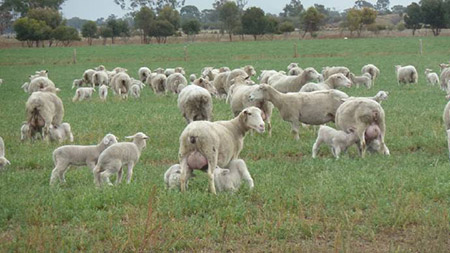For sheep producers, lamb marking time is a test of how well they have managed their ewes throughout joining, pregnancy and lambing. There are numerous reasons (and excuses) for poor or good lamb marking percentages per ewe joined; however this percentage doesn’t tell us the full story about where lamb losses occurred. Were the losses due to poor conception rates, abortions or poor lamb survival rates?
The majority of lamb deaths occur at, or within the first 48 hours after birth, although abortion storms may account for up to 20-30% losses due to certain diseases. Having pregnancy scanning data gives you the ability to calculate lamb survival rates by dividing the numbers of lambs marked by the number of expected foetuses.
Target conception rates for Merinos should be 120%, whilst crossbreds should conceive 30% more to achieve scanning percentages of at least 150%.
When calculating lamb survival rates in twin-bearing ewes (expected 200%); a lamb marking percentage of 150% would give a survival rate of 75% (150 divided
by 200).
Target survival rates for Merinos should be 92% for single bearing ewes and 75% for twin-bearing ewes; whilst First-cross ewes should achieve 97% for single bearing ewes and 87% for twin-bearing ewes.
Chasing high reproductive rates is not always linked to improved profitability according to benchmarking studies, particularly within the Merino ewe flock. However, with lower reproductive rates, there will be a reduced number of surplus sheep for sale, which reduces income opportunity when mutton and lamb prices are high; as well as reduced selection pressure and culling options. Additionally, it has been shown that maintaining a Merino lambing ewe in condition score (CS) 3 compared to CS 2.5, can lift profit by $20 per ewe by increasing wool production, reducing ewe deaths at lambing and increasing lamb progeny survival; not to mention improving the subsequent lifetime wool production of the progeny. In a crossbred enterprise, lambing percentage and stocking rate affect the amount of kilograms of meat produced per hectare, which does influence profitability within a prime lamb enterprise.
Regardless of profitability, animal welfare is important, and therefore using management strategies to improve survival is becoming increasingly important
to ensure consumer confidence in our industry.
As well as monitoring conception and survival rates of both ewes and lambs; it is also useful to record pasture quality and quantity and the CS of the ewes throughout the reproductive cycle. Numbers at joining, scanning, lamb marking and weaning, as well as kilograms of carcase weight sold can be recorded in a standard format each year to enable comparisons to be made easily. It’s also useful to write down notes on the amount and cost of any supplementary feed (as-fed), management strategies used and the type of season it was (time of break / finish and weather conditions at lambing). This information can be used historically to show how management and season affected reproductive rates; as well as helping to make future management decisions based on different seasonal conditions.
Tweet